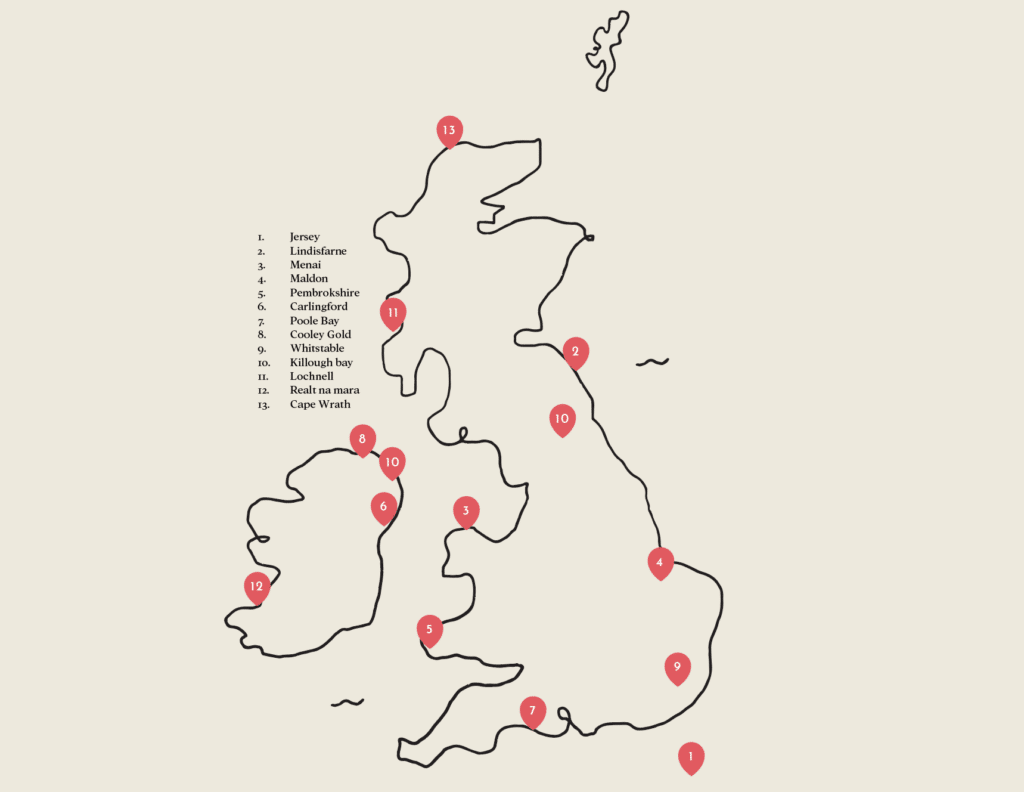![]()

![]()


We love our Oysters.
Oysters may be seen as an indulgent treat for the elite classes, but they’ve been a staple part of our diet since we were running around in animal fur pants! In fact, we weren’t really ‘cavemen’ we were foragers predominantly along coastlines and oysters were one of the key ingredients in our diet offering nutrients and specifically zinc that helped us evolve.
Jump forward a 100,000 years and the Roman’s arrived on our British Shores. They like us recognised that British Oysters were the best and started exporting our native oysters back, on what was known as the Oyster chain, running from Colchester to Rome. For elite familias to enjoy. Back in the UK oysters remained a cheap, easy to find food source for the masses. Until the 1850’s 250 million oysters passed through Billingsgate at a meat substitute for the growing population of London.
Sadly, we weren’t re-seeding and populations started to dwindle and the humble oyster became a refined treat for the upper classes. Stocks were at their lowest in the 1950’s with two world wars doing no favours for the profession of Oystermen. This was the turning point and in addition to our Native oysters’ individuals began the process of farming rock oysters in the UK, creating a sustainable, in fact beneficial farming practise in our waters.
As farming techniques improve and sales grow, more oysters are produced, and the price begins to drop down. We like to thing we are doing our bit supporting this with our £2 a pop happy hour, 12-6pm Monday to Friday (had to drop it in here).
Oysters are known as the ‘gems of the sea’ and as more or grown it’s beneficial to our oceans and coastlines. Oysters are the only form of protein that don’t need feeding a further protein to grow, they filter more than 5 litres of water per hour, contribute to reef development helping reduce flood risk & erosion and remove nitrogen from water improving the ecosystem.

“Maldon Oysters, £2 a pop Monday to Friday, 12-6pm.”
Here at Faber, we source our oysters from farms all around the British Isles including Ireland. Oysters from each location have a very distinct and unique flavour. Just like wine the flavour is derived from what is called ‘Merroir’, this can vary by rainfall, closeness to land for minerality, near to estuaries and seabed type. Here’s a little run down of our recommended locations:
1. Jersey Oysters, grown in the pristine waters of the English Channel, are known for their briny and mineral-rich taste.
2. Lindisfarne Oysters, grown in the tidal flats of Lindisfarne, Northumberland, these oysters have a subtly sweet and nutty flavour. And thanks to some illustrious monks it’s the oldest oyster farm in the world.
3. Menai Oysters, Menai oysters, cultivated in the Menai Strait, are celebrated for their clean, crisp, and slightly metallic taste.
4. Maldon Oysters, our ‘house’ harvested from the Blackwater River in Essex, Maldon oysters offer a unique balance of brininess and creaminess. Because of their all year-round consistency and relatively closeness we are able to get regular deliveries direct and offer at £2 during our happy hours Mon – Fri.
5. Pembrokeshire Oysters, hailing from the coast of Wales, provide a taste of the sea with a hint of earthiness.
6. Carlingford Oysters, from County Louth, Ireland, are prized for their robust and crisp flavour.
7. Poole Bay Oysters, grown in the sheltered waters of Poole Harbour, are characterized by their mild, sweet, and salty notes.
8. Cooley Gold Oysters, found in Carlingford Lough, are known for their full-bodied and buttery taste.
9. Whitstable Oysters, located in Kent, has a long history of producing European Flat Oysters, renowned for their refined flavour.
10. Killough Bay Oysters, on the coast of County Down, Northern Ireland, yields oysters with a delightful mix of saltiness and sweetness.
11. Lochnell Oysters, cultivated in Loch Nell, Scotland, they offer a distinctive flavour with a combination of creaminess and brininess.
12. Realt Na Mara Oysters, these oysters, grown off the west coast of Ireland, are favoured for their robust and mineral-rich taste.
13. Cape Wrath Oysters, in the remote Scottish Highlands, produces oysters with a unique blend of flavours from the cold, pristine waters.
How to eat an oyster.
First things first open and smell. Does it look good, does it smell good. Don’t chuck out the brine. This is 90% seawater. Sip it, it’s lovely. Notice the second release. Sip it, it’s less seawater and more Oyster liquor (the true essence of the oyster). It’s now time, eat the oyster, remember to chew, this releases the 3 separate characteristics of the oyster. Saltiness (the liquor or brine) sweetness from the” scallop-like” abductor muscle and the meaty umami flavour from the gill and body of the oyster. If just you swallow you just get salty, sadness!
Now notice the aftertaste. Fast growing oysters (warm climate or warm water) will have a meaty/plump texture but short aftertaste. Slow growing oysters (cold water) will have crisp texture and long complex aftertaste. This is to do with Merroir, that word again!!!
Just for good table manners, turn over the shells. We can also read the shell. Is it from fast moving water or slow-moving water. Compare the Jersey with Carlingford, the forming of barnacles on the oyster means it’s slow, lazy oysters!
The big match: rock vs native
Rocks, aka Gigas, Pacific’s: grow anywhere. Easily farmed. Hermaphroditism. Bisexual! Quick to mature, fast growers. Reproduce very successfully. Pollinate like a flower. Spat egg & sperm into the water. Don’t carry their young. On a farm, they can be moved. Yucky fact, at sexual peak their body is 80% gonads, lots of babies, 1,000,000!
Natives, Aka belons or flats: indigenous to the UK, Ireland, France. Grow in temperate climate. Don’t like extremes. Don’t like very strong currents. Don’t like being farmed or moved. Prima-donna! Slow to grow, 5 years to market size. They change sex but not as much, triggered by temperature change. Boy fertilised a girl oyster. She carries the fertilised eggs, like a marsupial. 250,000, not as prolific as Rocks. They grow wild, kind of randomly.
Remember the more we eat the more the price will drop.
Fresh fish for all!
Here’s just a few benefits of eating an oyster if you aren’t convinced already.
• Oysters are the best source of zinc.
• After spinach they are the highest source of folic acid.
• After liver they are the highest source of copper and iron.
• Clean lean source of protein. 12 oysters are the same as 150g beef steak in terms of protein, a fraction of the fat.
• A major source of omega 3 source.
• Vit c and Vit b
• High in Vit b12, good for production of testosterone.
• Zinc increases sperm production and sex drive, that’s where the aphrodisiac story derived from.
Pop your oyster £2 each Monday 12 – 6pm
We’ve been invited to host our very ow Chef’s fish counter and tasting menu at The Holborn Dining Room, part of The Rosewood Hotel London.
Read moreThis summer we’ll be taking up residency in collaboration with Setlist @ Somerset House. Shucking oysters on the riverside terrace
Read moreFaber’s Private Hire Oyster Bar adds a unique and luxurious touch to weddings, private parties, and corporate events.
Read more
